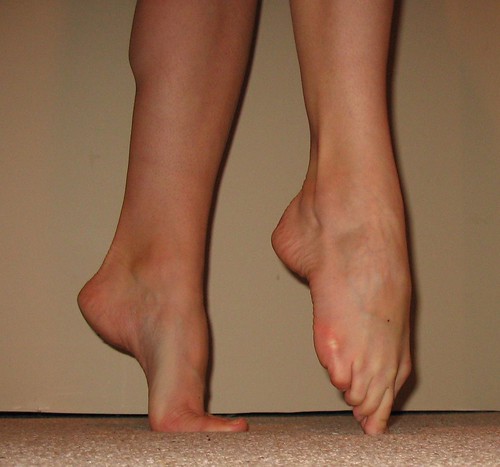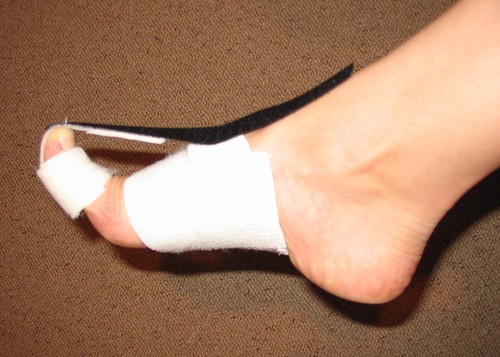The previous post dealt with feet, and so shall this one. Moving from the technical and aesthetic to the practical, I've dug up some resources on how to improve your foot's strength and flexibility.
But first, a photo of the feet of yours truly:
I have to say, I've always rather liked my feet! But I digress...
Foot muscles aren't exactly the focus of most strength training programs. Why would they be? They just sort of...exist, somewhere at the bottom of our legs. You can't see the plantar muscles rippling with power, not like you can with a well-toned set of quads. You stand on them, you walk around on them, you tiptoe on them in releve while drawing attention to your pistoning hips. Poor little neglected feet!
Strengthening your feet
Standing on the balls of your feet requires quite a lot of strength, and not just from your calf and leg muscles. Look back to the anatomy pictures linked in my previous post and gander at the network of muscles running around that bony framework and up the ankle. You want to be able to dance in releve for extended periods? Better start training that foot - your extensor muscles must pull your toes back while the pereonial tibial helps stabilize the ankle so you don't roll. You want to execute moves with a lovely balletic point? Start building up your flexors so you can strongly pull your toes and arch your foot. There's a lot more happening in those two moves with a cohort of smaller muscles too.
Plies, releves, and all sorts of movements requiring you to raise and lower your body using your feet are excellent for developing foot strength. Should you wish to work on more explosive power, you may wish to practice springing and hopping moves wherein you focus on using your feet and ankles (as opposed to your knees and thighs) to power the jumps.
If you would like a bit of extra assistance with your foot strengthening routine, you may wish to invest in a chunk of rubber tubing or rubber sheeting (such as a theraband) to give you some resistance training. These sorts of materials are available very cheaply from medical supply stores. An excellent set of foot strengthening exercises using a theraband are detailed in the following articls:
Theraband Exercises: Three for your Feet"
Developing flexibility
Proper flexibility will help prevent painful injuries. While you want your muscles to be nice and stable to minimize the potential for rolling, you also want them to be supple enough to allow your feet to bobble and roll properly without pulling muscles or tearing tendons.
It is very likely that your dance and exercise activities, along with many daily activities, provide most of the foot flexibility you need. If you think your muscles are a bit tight, though, this YouTube video will give you some ideas for additional stretches. You can practice these with tennis balls or any surface that allows you to deeply stretch your feet. The individual in the video is using a more specialized type of equipment for her foot stretches, but anything that allows you to do that sort of exercise is just fine.
I also managed to dig up a very entertaining medical article admonishing tight-fitting shoes and their impact on foot flexibility. The article dates back to 1898, thus reinforcing the notion that the more things change, the more they stay the same!
The Flexibility of the Human Foot
Recently, I've noticed a reduction in the flexibility of my right big toe. For reasons that the folks at a local rehab and therapy clinic could not determine, my mobility in my right big toe is about 10 degrees less than in my left big toe. This makes training for Turkish drops rather difficult, as I simply can't bend my big toe far enough to make it all the way to the floor without snapping the wretched thing off. The occupational therapist who was examining my feet understood why I wanted to regain some flexibility in that joint, so he gave me this nifty looking contraption:
Because foot muscles and tendons are very, very tight and strong, I need to keep my toe in that flexed position for a very long time. Actually, I need to keep it like that for hours. This means I have to wear the splint to bed. Sexy! It doesn't really feel like it's doing anything when I'm wearing it, but we will see what the results are like in a few weeks. I can sleep through anything, so I'm certainly willing to give it a try.
More foot injuries, specifically for dancers!
I provided links to info about foot injuries in my last post, but I am a sucker for this sort of information. I came across a particularly good article that is geared towards us prancers, and it would be a shame not to share this gem:
Common Dance Injuries: The Foot and Ankle
Benefits of Green Smoothies and How to Make Them
8 years ago
0 comments:
Post a Comment